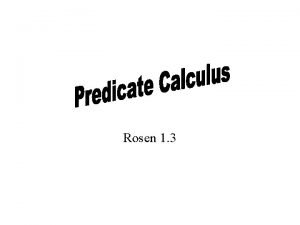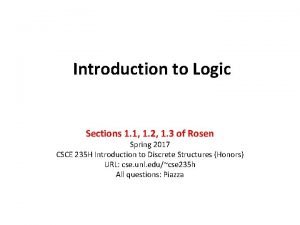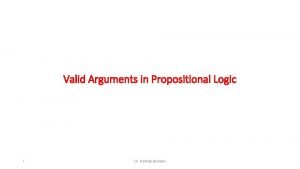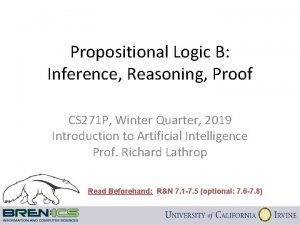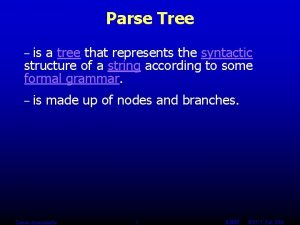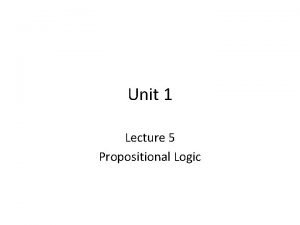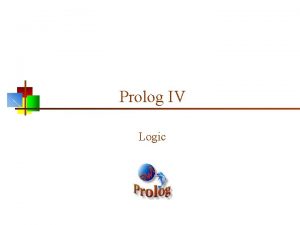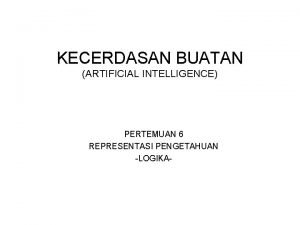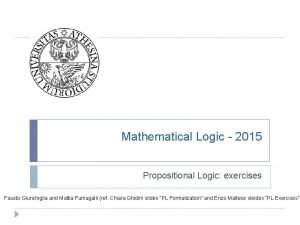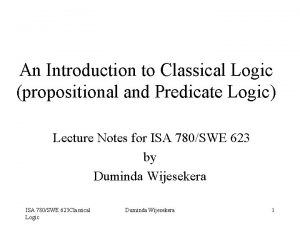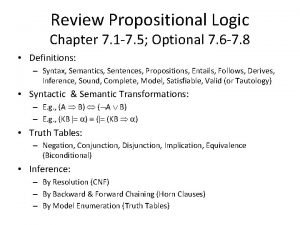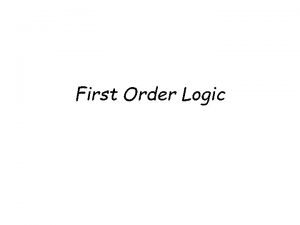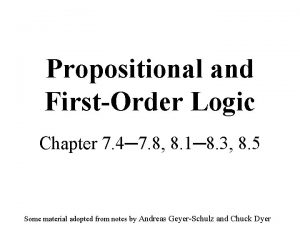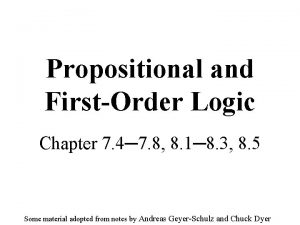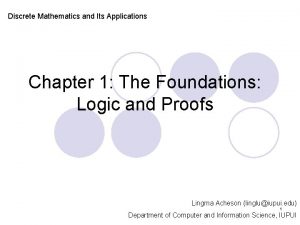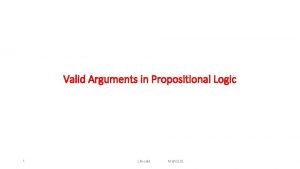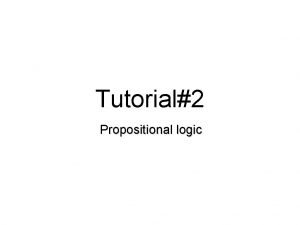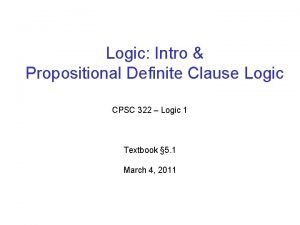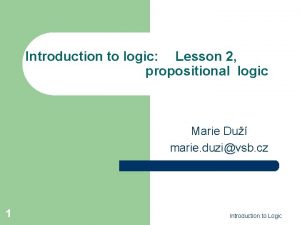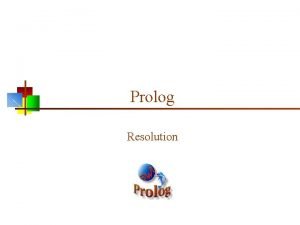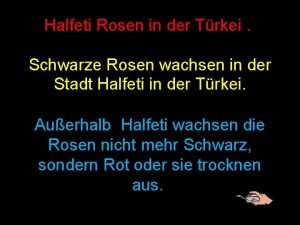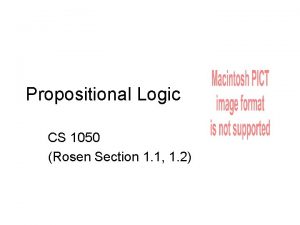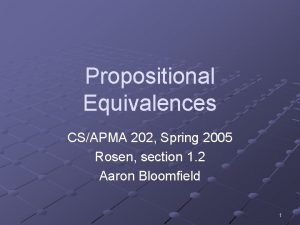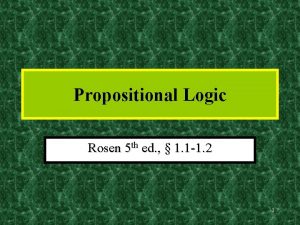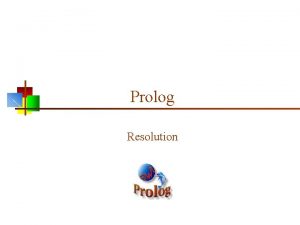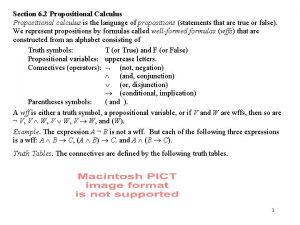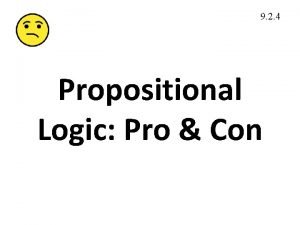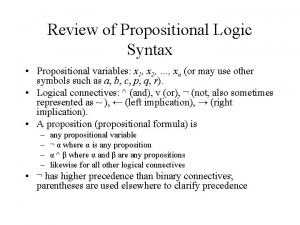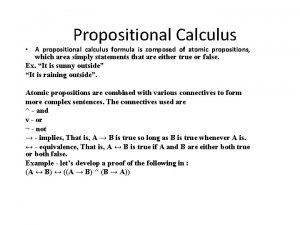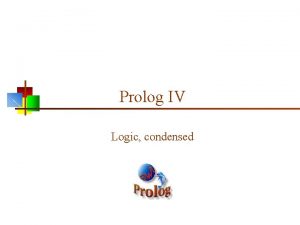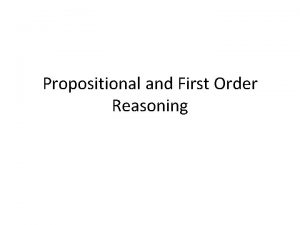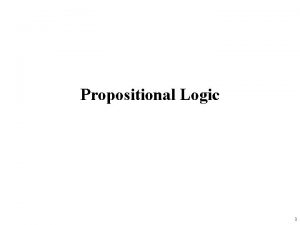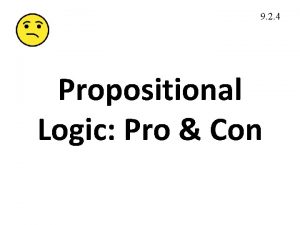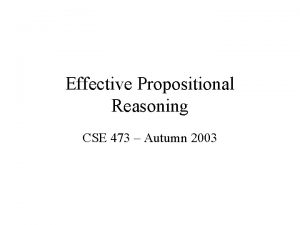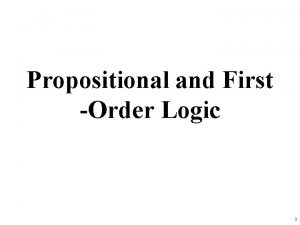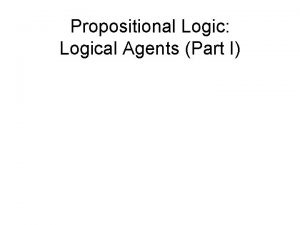Rosen 1 3 Propositional Functions Propositional functions or






























- Slides: 30

Rosen 1. 3

Propositional Functions • Propositional functions (or predicates) are propositions that contain variables. • Ex: Let P(x) denote x > 3 • P(x) has no truth value until the variable x is bound by either – assigning it a value or by – quantifying it.

Assignment of values Let Q(x, y) denote “x + y = 7”. Each of the following can be determined as T or F. Q(4, 3) Q(3, 2) Q(4, 3) Q(3, 2) [Q(4, 3) Q(3, 2)]

Quantifiers Universe of Discourse, U: The domain of a variable in a propositional function. Universal Quantification of P(x) is the proposition: “P(x) is true for all values of x in U. ” Existential Quantification of P(x) is the proposition: “There exists an element, x, in U such that P(x) is true. ”

Universal Quantification of P(x) x. P(x) “for all x P(x)” “for every x P(x)” Defined as: P(x 0) P(x 1) P(x 2) P(x 3) . . . for all xi in U Example: Let P(x) denote x 2 x If U is x such that 0 < x < 1 then x. P(x) is false. If U is x such that 1 < x then x. P(x) is true.

Existential Quantification of P(x) x. P(x) “there is an x such that P(x)” “there is at least one x such that P(x)” “there exists at least one x such that P(x)” Defined as: P(x 0) P(x 1) P(x 2) P(x 3) . . . for all xi in U Example: Let P(x) denote x 2 x If U is x such that 0 < x 1 then x. P(x) is true. If U is x such that x < 1 then x. P(x) is true.

Quantifiers x. P(x) • True when P(x) is true for every x. • False if there is an x for which P(x) is false. x. P(x) • True if there exists an x for which P(x) is true. • False if P(x) is false for every x.

Negation (it is not the case) x. P(x) equivalent to x P(x) • True when P(x) is false for every x • False if there is an x for which P(x) is true. x. P(x) is equivalent to x P(x) • True if there exists an x for which P(x) is false. • False if P(x) is true for every x.

Examples 2 a Let T(a, b) denote the propositional function “a trusts b. ” Let U be the set of all people in the world. Everybody trusts Bob. x. T(x, Bob) Could also say: x U T(x, Bob) denotes membership Bob trusts somebody. x. T(Bob, x)

Examples 2 b Alice trusts herself. T(Alice, Alice) Alice trusts nobody. x T(Alice, x) Carol trusts everyone trusted by David. x(T(David, x) T(Carol, x)) Everyone trusts somebody. x y T(x, y)

Examples 2 c x y T(x, y) Someone trusts everybody. y x T(x, y) Somebody is trusted by everybody. Bob trusts only Alice. x (x=Alice T(Bob, x))

Bob trusts only Alice. x (x=Alice T(Bob, x)) Let p be “x=Alice” q be “Bob trusts x” p T T F F q T F p q T F F T True only when Bob trusts Alice or Bob does not trust someone who is not Alice

Quantification of Two Variables (read left to right) x y. P(x, y) or y x. P(x, y) • True when P(x, y) is true for every pair x, y. • False if there is a pair x, y for which P(x, y) is false. x y. P(x, y) or y x. P(x, y) True if there is a pair x, y for which P(x, y) is true. False if P(x, y) is false for every pair x, y.

Quantification of Two Variables x y. P(x, y) • True when for every x there is a y for which P(x, y) is true. (in this case y can depend on x) • False if there is an x such that P(x, y) is false for every y. y x. P(x, y) • True if there is a y for which P(x, y) is true for every x. (i. e. , true for a particular y regardless (or independent) of x) • False if for every y there is an x for which P(x, y) is false. Note that order matters here In particular, if y x. P(x, y) is true, then x y. P(x, y) is true. However, if x y. P(x, y) is true, it is not necessary that y x. P(x, y) is true.

Examples 3 a Let L(x, y) be the statement “x loves y” where U for both x and y is the set of all people in the world. Everybody loves Jerry. x. L(x, Jerry) Everybody loves somebody. x y. L(x, y) There is somebody whom everybody loves. y x. L(x, y)

Examples 3 b 1 There is somebody whom Lydia does not love. x L(Lydia, x) Nobody loves everybody. (For each person there is at least one person they do not love. ) x y L(x, y) There is somebody (one or more) whom nobody loves y x L(x, y)

Examples 3 b 2 There is exactly one person whom everybody loves. x y. L(y, x)? No. There could be more than one person everybody loves x{ y. L(y, x) w[( y. L(y, w)) w=x]} If there are, say, two values x 1 and x 2 (or more) for which L(y, x) is true, the proposition is false. x{ y. L(y, x) w[( y. L(y, w)) w=x]}? x w[( y L(y, w)) w=x]?

Examples 3 c There are exactly two people whom Lynn loves. x y{x y L(Lynn, x) L(Lynn, y)}? No. x y{x y L(Lynn, x) L(Lynn, y) z[L(Lynn, z) (z=x z=y)]} Everyone loves himself or herself. x. L(x, x) There is someone who loves no one besides himself or herself. x y(L(x, y) x=y)

Thinking of Quantification as Loops Quantifications of more than one variable can be thought of as nested loops. • For example, x y. P(x, y) can be thought of as a loop over x, inside of which we loop over y (i. e. , for each value of x). • Likewise, x y. P(x, y) can be thought of as a loop over x with a loop over y nested inside. This can be extended to any number of variables.

Quantification as Loops Using this procedure • x y. P(x, y) is true if P(x, y) is true for all values of x, y as we loop through y for each value of x. • x y. P(x, y) is true if P(x, y) is true for at least one set of values x, y as we loop through y for each value of x. …And so on….

Quantification of 3 Variables Let Q(x, y, z) be the statement “x + y = z”, where x, y, z are real numbers. What is the truth values of • x y z. Q(x, y, z)? • z x y. Q(x, y, z)?

Quantification of 3 Variables Let Q(x, y, z) be the statement “x + y = z”, where x, y, z are real numbers. • x y z. Q(x, y, z) is the statement, “For all real numbers x and for all real numbers y, there is a real number z such that x + y = z. ” True

Quantification of 3 Variables Let Q(x, y, z) be the statement “x + y = z”, where x, y, z are real numbers. z x y. Q(x, y, z) is the statement, “There is a real number z such that for all real numbers x and for all real numbers y, x + y = z. ” False

Examples 4 a Let P(x) be the statement: “x is a Georgia Tech student” Q(x) be the statement: “ x is ignorant” R(x) be the statement: “x wears red” and U is the set of all people. No Georgia Tech students are ignorant. x(P(x) Q(x)) x( P(x) Q(x)) OK by Implication equivalence. x(P(x) Q(x)) Does not work. Why?

Examples 4 a No Georgia Tech students are ignorant. x(P(x) Q(x)) x (P(x) Q(x)) Negation equivalence x ( P(x) Q(x)) Implication equivalence x ( P(x) Q(x)) De. Morgans x ( P(x) Q(x)) Double negation Only true if everyone is a GT student and is not ignorant.

Examples 4 a P(x) be the statement: “x is a Georgia Tech student” Q(x) be the statement: “ x is ignorant” R(x) be the statement: “x wears red” and U is the set of all people. No Georgia Tech students are ignorant. x(P(x) Q(x)) Also works. Why?

Examples 4 a No Georgia Tech students are ignorant. x(P(x) Q(x)) x (P(x) Q(x)) Negation equivalence x ( P(x) Q(x)) De. Morgan x (P(x) Q(x)) Implication equivalence

Examples 4 b Let P(x) be the statement: “x is a Georgia Tech student” Q(x) be the statement: “ x is ignorant” R(x) be the statement: “x wears red” and U is the set of all people. All ignorant people wear red. x(Q(x) R(x))

Examples 4 c Let P(x) be the statement: “x is a Georgia Tech student” Q(x) be the statement: “ x is ignorant” R(x) be the statement: “x wears red” and U is the set of all people. No Georgia Tech student wears red. x(P(x) R(x)) What about this? x(R(x) P(x))

Examples 4 d If “no Georgia Tech students are ignorant” and “all ignorant people wear red”, does it follow that “no Georgia Tech student wears red? ” x((P(x) Q(x)) (Q(x) R(x))) NO Some misguided GT student might wear red!! This can be shown with a truth table or Wenn diagrams
 Rosen die ich an dich verschenke
Rosen die ich an dich verschenke Eddie rosen brian rosen
Eddie rosen brian rosen Propositional functions examples
Propositional functions examples Propositional logic cheat sheet
Propositional logic cheat sheet Valid arguments in propositional logic
Valid arguments in propositional logic Propositional logic notation
Propositional logic notation Parse tree example
Parse tree example What is mathematical system
What is mathematical system Propositional logic
Propositional logic Propositional logic
Propositional logic Propositional logic adalah
Propositional logic adalah Propositional logic exercises
Propositional logic exercises Semantics of predicate logic
Semantics of predicate logic Xor in propositional logic
Xor in propositional logic Biconditional
Biconditional ___________ is the limitation of propositional logic
___________ is the limitation of propositional logic Propositional logic signs
Propositional logic signs Translation
Translation Implies in propositional logic
Implies in propositional logic Xor in propositional logic
Xor in propositional logic Propositional logic
Propositional logic Rezolution v2
Rezolution v2 Propositional logic examples and solutions
Propositional logic examples and solutions Cpsc 322
Cpsc 322 Implies in propositional logic
Implies in propositional logic Equivalence word level
Equivalence word level Propositional network
Propositional network What is a wff in logic
What is a wff in logic Discrete math propositional logic
Discrete math propositional logic Kinship domain in artificial intelligence
Kinship domain in artificial intelligence Proposition examples sentences
Proposition examples sentences


